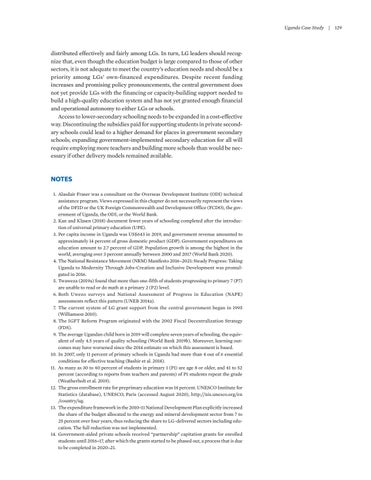Uganda Case Study | 129
distributed effectively and fairly among LGs. In turn, LG leaders should recognize that, even though the education budget is large compared to those of other sectors, it is not adequate to meet the country’s education needs and should be a priority among LGs’ own-financed expenditures. Despite recent funding increases and promising policy pronouncements, the central government does not yet provide LGs with the financing or capacity-building support needed to build a high-quality education system and has not yet granted enough financial and operational autonomy to either LGs or schools. Access to lower-secondary schooling needs to be expanded in a cost-effective way. Discontinuing the subsidies paid for supporting students in private secondary schools could lead to a higher demand for places in government secondary schools; expanding government-implemented secondary education for all will require employing more teachers and building more schools than would be necessary if other delivery models remained available.
NOTES 1. Alasdair Fraser was a consultant on the Overseas Development Institute (ODI) technical assistance program. Views expressed in this chapter do not necessarily represent the views of the DFID or the UK Foreign Commonwealth and Development Office (FCDO), the government of Uganda, the ODI, or the World Bank. 2. Kan and Klasen (2018) document fewer years of schooling completed after the introduction of universal primary education (UPE). 3. Per capita income in Uganda was US$643 in 2019, and government revenue amounted to approximately 14 percent of gross domestic product (GDP). Government expenditures on education amount to 2.7 percent of GDP. Population growth is among the highest in the world, averaging over 3 percent annually between 2000 and 2017 (World Bank 2020). 4. The National Resistance Movement (NRM) Manifesto 2016–2021: Steady Progress: Taking Uganda to Modernity Through Jobs-Creation and Inclusive Development was promulgated in 2016. 5. Twaweza (2019a) found that more than one-fifth of students progressing to primary 7 (P7) are unable to read or do math at a primary 2 (P2) level. 6. Both Uwezo surveys and National Assessment of Progress in Education (NAPE) assessments reflect this pattern (UNEB 2014a). 7. The current system of LG grant support from the central government began in 1995 (Williamson 2010). 8. The IGFT Reform Program originated with the 2002 Fiscal Decentralization Strategy (FDS). 9. The average Ugandan child born in 2019 will complete seven years of schooling, the equivalent of only 4.5 years of quality schooling (World Bank 2019b). Moreover, learning outcomes may have worsened since the 2014 estimate on which this assessment is based. 10. In 2007, only 11 percent of primary schools in Uganda had more than 4 out of 6 essential conditions for effective teaching (Bashir et al. 2018). 11. As many as 30 to 40 percent of students in primary 1 (P1) are age 8 or older, and 41 to 52 percent (according to reports from teachers and parents) of P1 students repeat the grade (Weatherholt et al. 2019). 12. The gross enrollment rate for preprimary education was 14 percent. UNESCO Institute for Statistics (database), UNESCO, Paris (accessed August 2020), http://uis.unesco.org/en /country/ug. 13. The expenditure framework in the 2010–11 National Development Plan explicitly increased the share of the budget allocated to the energy and mineral development sector from 7 to 25 percent over four years, thus reducing the share to LG-delivered sectors including education. The full reduction was not implemented. 14. Government-aided private schools received “partnership” capitation grants for enrolled students until 2016–17, after which the grants started to be phased out, a process that is due to be completed in 2020–21.






